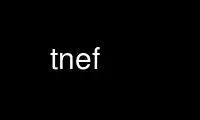
This is the command tnef that can be run in the OnWorks free hosting provider using one of our multiple free online workstations such as Ubuntu Online, Fedora Online, Windows online emulator or MAC OS online emulator
PROGRAM:
NAME
tnef - decode Microsoft's Transport Neutral Encapsulation Format
SYNOPSIS
tnef [options] [FILE]
tnef {--help | --version}
DESCRIPTION
This manual page documents the tnef filter. tnef decodes e-mail attachments encoded in
Microsoft's Transport Neutral Encapsulation Format (hereafter, TNEF), which "wraps"
Microsoft e-mail attachments.
Unfortunately, these "wrapped" attachments are inaccessible to any e-mail client that does
not understand TNEF. Fortunately, the tnef filter can be used by any MIME-aware client to
unpack these attachments.
OPTIONS
-f FILE, --file=FILE
use FILE as input ('-' denotes stdin). When this option is omitted, tnef reads
data from stdin.
-C DIR, --directory=DIR
unpack file attachments into DIR.
-x SIZE, --maxsize=SIZE
limit maximum size of extracted archive (bytes)
-t, --list
list attached files, do not extract.
-w, --interactive, --confirmation
ask for confirmation for every action.
--overwrite
when extracting attachments, overwrite existing files.
--number-backups
when extracting attachments, if file FOO will be overwritten, create FOO.n instead.
--use-paths
honor file pathnames specified in the TNEF attachment. For security reasons, paths
to attached files are ignored by default.
--save-body FILE
Save message body data found in the TNEF data. There can be up to three message
bodies in the file, plain text, HTML encoded, and RTF encoded. Which are saved is
specified by the --body-pref option. By default the message bodies are written to
a file named message with an extension based upon the type (txt, html, rtf).
--body-pref PREF
Specifies which of the possibly three message body formats will be saved. PREF can
be up to three characters long and each character must be one of 'r', 'h', or 't'
specifying RTF, HTML or text. The order is the order that the data will be
checked, the first type found will be saved. If PREF is the special value of 'all'
then any and all message body data found will be saved. The default is 'rht'.
--save-rtf FILE
DEPRECATED. Equivalent to --save-body=FILE --body-pref=r
-h, --help
show usage message.
-V, --version
display version and copyright.
-v, --verbose
produce verbose output.
--debug
enable debug output.
EXAMPLE
The following example demonstrates typical tnef usage with a popular Unix mail client
called "mutt".
Step 1 -- Configure ~/.mailcap
Mutt can't use tnef for its intended purpose until an appropriate content type definition
exists in ~/.mailcap . Here's a sample definition:
application/ms-tnef; tnef -w %s
This mailcap entry says that whenever the MIME content type:
application/ms-tnef
is encountered, use this command to decode it:
tnef -w %s
The latter command string invokes tnef, specifying both the -w option and the attachment
(created as a temporary file) as command line arguments.
Step 2 -- Add The Filter To $PATH
Mutt can't invoke tnef if the filter isn't accessible via $PATH.
Step 3 -- Test Mutt
Use mutt to read a message that includes a TNEF attachment. Mutt will note that an
attachment of type "application/ms-tnef is unsupported".
Press the "v" key to open mutt's "view attachment" menu.
Move the cursor over the TNEF attachment and press the enter key to "view" the attachment.
Mutt will launch tnef and invoke it using the command line syntax specified in ~/.mailcap
(step 1). tnef then decodes all file(s) included in the TNEF attachment, prompting for
confirmation prior to creating an individual file (refer to -w option above). -w is
useful here because it gives the end user a chance to view the filename(s) included in the
mail message.
Note that Mutt's attachment menu also supports a pipe option, which permits the user to
pipe attachments to an external filter (how convenient). So, to list the contents of a
TNEF attachment prior to decoding it, press the "|" key and enter this command:
tnef -t
Use tnef online using onworks.net services
